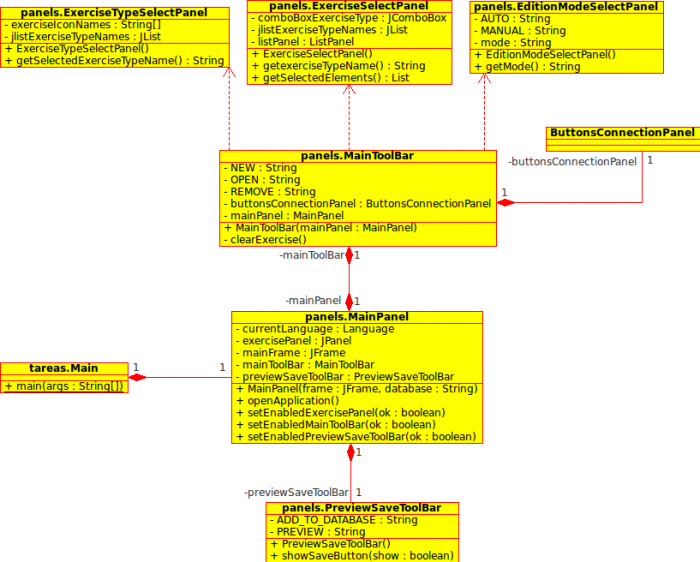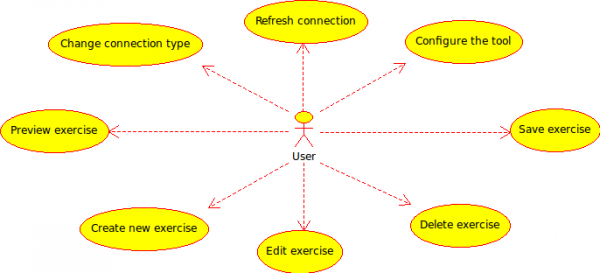Tareas: General part
From PatioWiki
m |
|||
| Line 23: | Line 23: | ||
| - | [[ | + | [[File:Tareas_general_use_cases_diagram_en.png |600px|General use case diagram of Tareas.]] |
| Line 41: | Line 41: | ||
| - | [[ | + | [[File:Tareas_diagrama_secuencias_cambiar_tipo_conexion_es.png|450px|Diagrama de secuencias de Tareas: Cambiar tipo de conexión.]] |
Revision as of 11:24, 13 October 2011
This section contains all the technical information relating to the part of the tool that is common to all the exercises editors that are part of Tareas.
Class diagrams
The following image shows the summarized class diagram of the general part of Tareas.
As shown in the diagram above, there is a main class called "MainPanel" which represents the main panel of the tool. This class contains both the main toolbar ("mainToolBar") as the bottom toolbar ("previewSaveToolBar"). Between them stands the "exercisePanel" panel, where all the exercise editors will be shown. The main class is also responsible for storing any general information of the tool.
The class "mainToolBar", which is the main toolbar, is responsible to perform operations like create, edit and delete exercises, and is also used for establishing the configuration of the tool. To perform these operations, some panels like "ExerciseTypeSelectPanel" (for selecting the exercise type) or "ButtonsConnectionPanel" (for the configuration of the tool) can be shown to the user.
Using the "previewSaveToolBar" toolbar, you can make operations of the last phase of creating an exercise like preview or save an exercise.
When loading an exercises editor at the "exercisePanel" panel, the top toolbar ("mainToolBar") does not change and, therefore, will be the same for all editors types. However, the bottom toolbar may vary depending on the exercise type and the editing mode you are using.
Use cases
The following image shows the use case diagram of the general part of Tareas.
Next there is a textual description of the general use cases of Tareas.
1. Use case: Change connection type.
Main actor: User.
Preconditions: Tareas must be running and the connection configuration parameters must be properly configured.
Main success scenario:
1. The user clicks on the select connection type panel located in the toolbar.
2. Tareas shows all the available connection types.
3. The user selects the connection type.
4. Tasks attempts a connection to the selected database.
5. The connection to the dabase is completed succesfully.
6. Tareas updates all its components according to data obtained from the database.
File:Tareas diagrama secuencias cambiar tipo conexion es.png
2. Use case: Refresh connection.
Main actor: User.
Preconditions: Tareas must be running and the connection configuration parameters must be properly configured.
Main success scenario:
1. The user clicks the "Refresh" button located in the toolbar.
2. Tareas attempts to reconnect to the selected database.
3. The reconnection to the dabase is completed succesfully.
4. Tareas updates all its components according to data obtained from the database.
3. Use case: Configure the tool.
Main actor: User.
Preconditions: Tareas must be running.
Main success scenario:
1. The user clicks the "Configure" button located in the toolbar.
2. Tareas shows the window that allow to set the configuration parameters of the tool.
4. Use case: Create new exercise.
Main actor: User.
Preconditions: Tareas must be running.
Main success scenario:
1. The user clicks the "New" button located in the toolbar.
2. Tareas shows the window for the selection of the exercise type that will be created.
3. The user selects the exercise type and presses the "Ok" button.
4. Tareas shows the window for the selection of the edition mode.
5. The user selects the edition mode and presses the "Ok" button.
6. Tareas creates a new exercise of the selected type, loads it into the appropiate manual editor and shows it to the user.
5. Use case: Edit exercise.
Main actor: User.
Preconditions: Tareas must be running and the exercise must exist.
Main success scenario:
1. The user clicks the "Open" button located in the toolbar.
2. Tareas shows the window for the selection of the exercise type that will be edited.
3. The user selects the exercise type to edit.
4. Tareas shows the available exercises of the selected type.
5. The user selects the exercise and presses the "Ok" button.
6. Tareas opens the selected exercise with the exercises editor of the selected type ready for his edition.
6. Use case: Delete exercise.
Main actor: User.
Preconditions: Tareas must be running and the exercise must exist.
Main success scenario:
1. The user clicks the "Delete" button located in the toolbar.
2. Tareas shows the window for the selection of the exercise type that will be removed.
3. The user selects the exercise type to remove.
4. Tareas shows the available exercises of the selected type.
5. The user selects the exercise or exercises and presses the "Ok" button.
6. Tareas shows a confirm message before continuing the process.
7. The user presses the "Ok" button and the process continues.
8. Tareas removes the selected exercises from the database.
9. Tareas shows a success message to the user .
550px|Diagrama de secuencias de Tareas: Borrar ejercicios.
7. Use case: Preview exercise.
Main actor: User.
Preconditions: Tareas must be running and the exercise that is being edited must have all required information.
Main success scenario:
1. The user clicks the "Preview" button located in the lower toolbar.
2. Tareas loads the exercise that is being edited with the Aprendo module panel that allows the exercises reproduction.
3. Aprendo starts executing the exercise.
4. Tareas displays a new window with the reproduction of the exercise that is being edited.
4. The user presses the "Ok" button to finish.
5. Tareas ends the exercise reproduction at Aprendo and returns to the exercises editor in the state it had before the preview.
500px|Diagrama de secuencias de Tareas: Previsualizar ejercicio.
8. Use case: Save exercise.
Main actor: User.
Preconditions: Tareas must be running and the exercise that is being edited must have all required information.
Main success scenario:
1. The user clicks the "Save" button located in the lower toolbar.
2. Tareas shows a confirm message before continuing the process.
3. The user presses the "Ok" button and the save process continues.
4. Tareas saves the exercise in the selected database.
5. Tareas shows a success message to the user.


